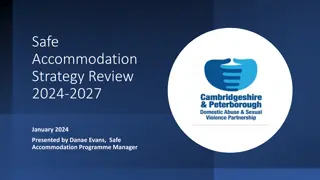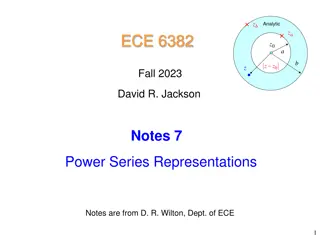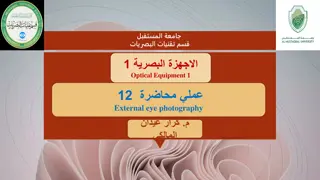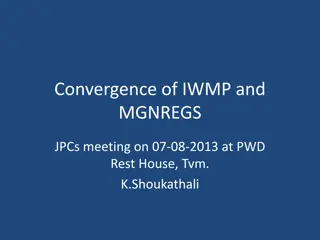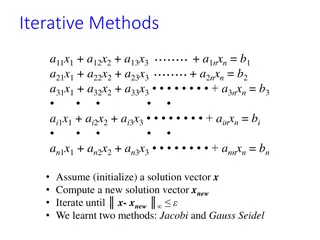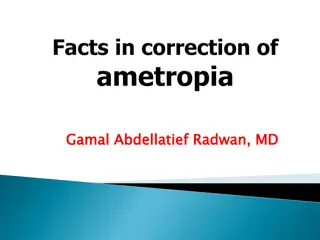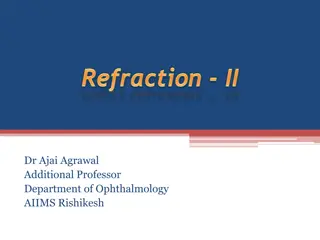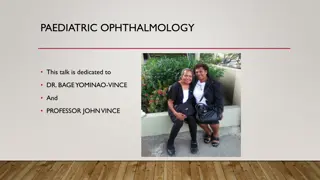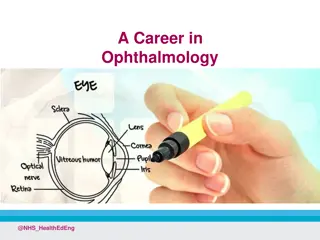Understanding Accommodation and Convergence in Ophthalmology
This presentation by Dr. Ajai Agrawal covers the mechanisms of accommodation and convergence in the eye, essential for focusing at different distances. It discusses the anatomy, reflexes, and theories related to these processes, providing a comprehensive overview for students and professionals in the field of ophthalmology.
Download Presentation

Please find below an Image/Link to download the presentation.
The content on the website is provided AS IS for your information and personal use only. It may not be sold, licensed, or shared on other websites without obtaining consent from the author. Download presentation by click this link. If you encounter any issues during the download, it is possible that the publisher has removed the file from their server.
E N D
Presentation Transcript
ACCOMMODATION AND CONVERGENCE Dr. Ajai Agrawal Additional Professor Department of Ophthalmology AIIMS, Rishikesh 1
Acknowledgement Figures in the presentation are courtesy: Dr.T.W.Vanderah and Dr.D.J.Gould (Nolte s The Human Brain, 7th Ed.) 2
Learning Objectives At the end of the class, students shall be able to Understand the basic mechanism of accommodation and clinical importance of anomalies of accommodation Understand the pathway for the near reflex and importance of convergence insufficiency. 3
ACCOMMODATION Definition: Accommodation is the mechanism by which the eye changes its refractive power by altering the shape of the lens in order to focus objects at variable distances. 4
Mechanism of accommodation Increase in the curvature of the lens affects mainly the anterior surface. Radius of curvature of anterior surface :10 mm During accommodation 6 mm This alteration in shape increases the converging power of the lens. 5
RELAXATION THEORY OF HELMONTZ He considered that lens was elastic and in normal state is stretched and flattened by the tension of the suspensory ligament. During accommodation: Ciliary muscle contracts causing the lens zonules to slacken, lens assumes more spherical form increasing thickness and decreasing diameter, protrusion forwards at the centre and a relative flattening at the periphery. 6
NEAR REFLEX It has 2 components : Convergence reflex comprising convergence of the visual axes of the eyes and associated constriction of pupil. Accommodation reflex includes increased accommodation and associated constriction of pupil. The near reflex comprises : Accommodation , convergence and miosis. 8
ACCOMODATION REFLEX Afferent impulses-from the retina to the parastriate cortex Internuncial fibres relay impulses from parastriate cortex to Edinger westphal nucleus of both sides Efferent fibres from Edinger westphal nucleus the efferent impulses travel along the 3rd nerve and reach the sphincter pupillae and ciliary muscle 9
Physical and physiological accommodation Two factors in accommodation Ability of lens to alter its shape Power of the ciliary muscle 1.Physical accommodation- Expression of the actual physical deformation of the lens, measured in dioptres. 2. Physiological accommodation- Contractile power of the ciliary muscle required to raise the refractive power of the lens , measured in myodioptres. 10
The far point of distinct vision is the position of an object such that its image falls on the retina in the relaxed eye, i.e. in the absence of accommodation. The far point of the emmetropic eye is at infinity. The near point of distinct vision is the nearest point at which an object can be clearly seen when maximum accommodation is used. 11
The range of accommodation is the distance between the far point and the near point. The amplitude of accommodation is the difference in dioptric power between the eye at rest and the fully accommodated eye. 12
The amplitude of accommodation is given by the formula A = P - R where A is the amplitude of accommodation in dioptres P is the dioptric value of the near point distance R is the dioptric value of the far point distance. 13
Applying this formula to the case of an emmetropic eye with a near point of 10 cm, P = 10 D ( the reciprocal of 0.10 m ) R = 0 ( the reciprocal of infinity is zero) A = 10 D 14
Far point and near point of the eye vary with the static refraction of the eye In a hypermetrope eye far point is virtual and lies behind the eye In a myopic eye far point is real and lies in front of the eye. 15
In an emmetropic eye Far point is at infinity Near point varies with age About 7 cm at age of 10 years About 25 cm at age of 40 years 33 cm at age of 45 years 16
ANOMALIES OF ACCOMMODATION INCREASED ACCOMMODATION DIMINISHED ACCOMMODATION 1. PHYSIOLOGICAL (PRESBYOPIA ) 2. PHARMACOLOGICAL (Cycloplegia) 3. PATHOLOGICAL Insufficiency of accommodation Ill sustained accommodation Paralysis of accommodation 1. EXCESSIVE ACCOMMODATION 2. SPASM OF ACCOMMODATION 17
PRESBYOPIA Presbyopia is not an error of refraction but a condition of physiological insufficiency of accommodation due to reduced amplitude of accommodation, leading to a progressive fall in near vision. This begins between 40 years and 45 years. 18
After the age of 40 years ,the NPA recedes beyond the normal reading distance. This condition of falling near vision due to age related decrease in the amplitude of accommodation or increase in punctum proximum is presbyopia. 19
Causes of presbyopia : Age related changes in lens which include Decrease in elasticity of lens capsule Progressive increase in size and hardness (sclerosis) of lens substance. Age related decline in ciliary muscle power. 20
Causes of premature presbyopia include Uncorrected hypermetropia Premature sclerosis of the crystalline lens General debility causing presenile weakness of ciliary muscle Chronic simple glaucoma 21
Symptoms Difficulty in near vision : patients start complaining of inadequacy of vision for small print and finer objects at the usual reading distance. Such problems start occurring in the evening, and in dim light. Asthenopic symptoms due to fatigue of ciliary muscle Intermittent diplopia at near may develop. 22
Treatment Optical correction of presbyopia Done by supplementing accommodation with convex lens of appropriate power. The difference between the distance correction and the strength needed for near vision is called the add. 23
PRESBYOPIC ADD If the patient is presbyopic, calculate the likely reading addition and add this to the distance lenses in the trial frame. In practice the reading addition is estimated from the patient's age. AGE RANGE READING ADDITION 45-50 YEARS +1.00 D 50-55 YEARS +1.50 D 55-60 YEARS +2.00D OVER 6O YEARS +2.50 D 24
MODES OF PRESCRIBING PRESBYOPIC ADD o SPECTACLES o CONTACT LENSES FOR PRESBYOPIA 2.SURGICAL TREATMENT OF PRESBYOPIA o refractive surgeries 25
Insufficiency of accommodation Accommodative power is significantly and persistently below the normal physiological limits for the patient s age Causes Premature sclerosis of lens Weakness of ciliary muscle due to systemic causes such as diabetes mellitus. 26
Clinical features : Treatment : 1.Treatment of the Headache systemic cause Fatigue 2.Near vision spectacles Blurring of vision for near 3.Accomodation exercises work Intermittent diplopia 27
Paralysis of accommodation Paralysis of accommodation ,also known as cycloplegia, refers to complete absence of accommodation. 28
Causes Drug induced Internal ophthalmoplegia Paralysis of accommodation as a component of 3rd nerve palsy. 29
DRUG MAXIMUM MYDRIASIS MAXIMUM CYCLOPLEGIA DURATION OF MYDRIASIS DURATION OF CYCLOPLEGIA ATROPINE 1% TID 30-40 MIN 1 DAY 7-10 DAYS 2 WEEKS CYCLOPENTOLATE 0.5%-1% 15 MIN 15-30 MIN 1 DAY 24 HRS HOMATROPINE 2% 30-60 MIN 30-60 MIN 1-2 DAYS 1-2 DAYS TROPICAMIDE 0.5%-1% 15-30 MIN 20-25 MIN 4-6 HRS 5-6 HRS 30
Treatment Clinical features Blurring of near vision Self recovery-drug induced Photophobia (due to paralysis and in cases when systemic cause is treated. mydriasis ) Dark glasses reduce glare Micropsia Convex lenses for near abnormal receding of near vision if paralysis is point permanent. Signs of 3rd nerve palsy 31
Excessive accommodation A situation in which an individual exerts more than the normal required accommodation for performing a certain near work. Excessive near work is an important precipitating factor especially when done in inadequate illumination. 32
Clinical features Varying degrees of blurred vision Symptoms of accommodative asthenopia Near vision difficulty 33
Treatment 1. Optical treatment : refractive error to be corrected 2. General treatment : Near work should be minimised and when done should be in proper illumination. 3. The general health of the patient should be improved. 34
CONVERGENCE 35
Definition: Convergence is a disconjugate movement in which both eyes rotate inward so that the lines of sight intersect in front of the eyes. Allows bifoveal single vision to be maintained at any fixation distance. Convergence does not deteriorate with increasing age. The power of convergence can be increased by exercises. 36
Convergence reflex Afferent pathway the afferents from medial recti travel centrally via the 3rd nerve to the mesencephalic nucleus of the 5th nerve, to a presumptive convergence centre in tectal or pretectal region. Internuncial fibres : from the convergence centre go to the Edinger Westphal nucleus . 37
Efferent pathway- along the 3rd nerve. From the 3rd nerve efferent fibres of convergence reflex relay in the accessory ganglion, before reaching sphincter pupillae. 38
Angle of convergence It refers to the angle that is formed between the primary lines of sight during convergence Its size depends on the fixation distance and interpupillary distance ( IPD ) 39
Metre angle One metre angle convergence is exerted by each eye when the eyes are directed to object at a distance of 1 m of the meridian line between the two eyes. 40
In an emmetropic eye, the number of dioptres of accommodation required to see an object clearly is equal to the number of metre angles through which each eye must converge to see the object singly. Thus 1D of accommodation is associated with 1 ma of convergence of each eye 41
The near point of convergence is the closest point at which an object can be seen singly during bifoveal vision when maximum convergence is exerted. The far point of convergence refers to relative position of the eyes when they are completely at rest, usually at infinity. 42
The range of convergence is the distance between the far point and the near point of convergence The amplitude of convergence is the difference in convergence power exerted to maintain the eye in a position at rest and in a position of maximum convergence. 43
Measurement of amplitude of convergence 1. Prism bar 2. Synoptophore 44
Anomalies of convergence 1)Convergence insufficiency Inability to maintain adequate binocular convergence for any length of time without undue effort. 45
Aetiology A. Primary or idiopathic wide IPD, general debility, overwork. B. Refractive errors- uncorrected high hypermetropia and myopia C. Presbyopia D. Muscular imbalances- exophoria, intermittent exotropia and vertical muscle imbalances. 46
Clinical features 2. Symptoms due to failure to maintain binocular vision Blurred near vision Intermittent crossed diplopia 1. Symptoms of muscular fatigue Eyestrain Headache and eye ache Difficulty in changing the focus from distant to near Itching, burning and soreness of eyes 47
Diagnosis 1. Remote NPC if NPC > 10 cm, Convergence insufficiency is said to exist. 2. Decreased fusional convergence for near-when measured on synoptophore, if there is difficulty in attaining 30 of convergence. 3. Exophoria 48
Treatment 1. Optical treatment- Myopes are given full correction and hypermetropes undercorrection to stimulate their accommodation and simultaneously convergence. 2. Orthoptic treatment- exercises to increase the near point of convergence (NPC) and also to increase amplitude of fusional convergence. 49
3. Prism Therapy Base in ( BI ) prisms reading glasses or bifocals with prism in the lower segment are useful. 4. Surgical treatment Last resort Medial rectus muscle resection can be performed. 50




